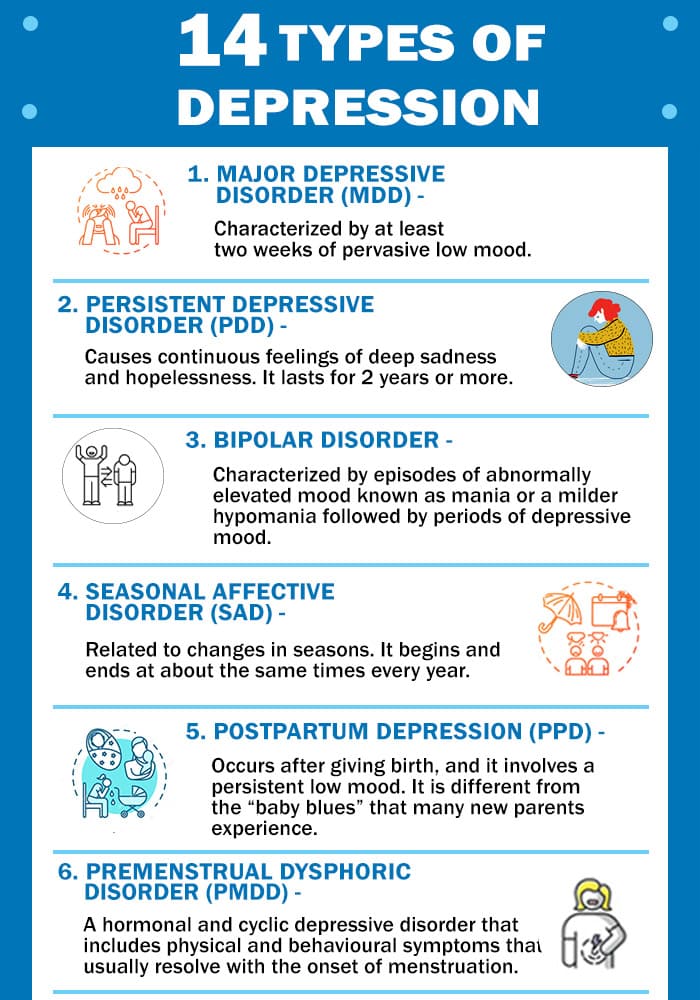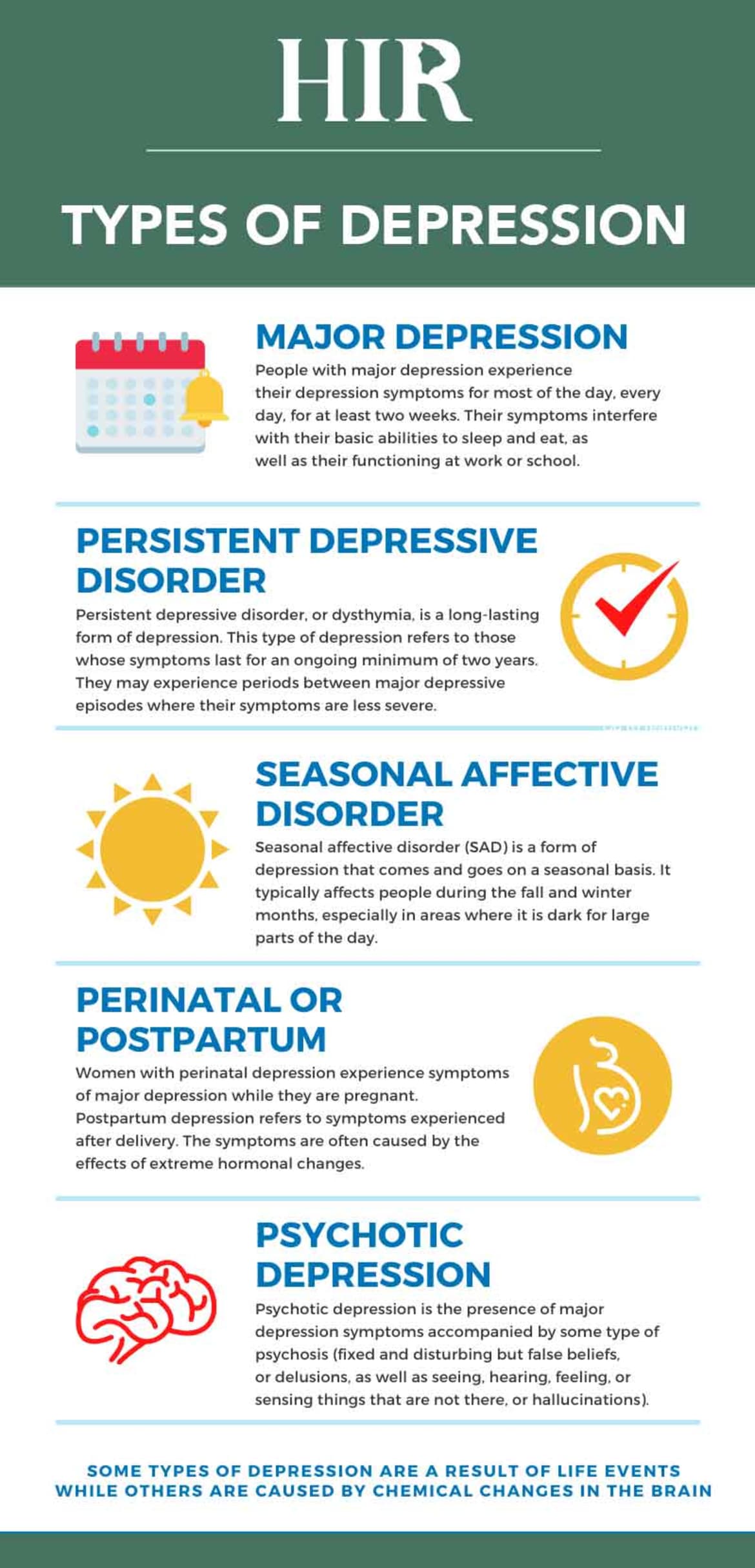Feelings of guilt or worthlessness Reduced concentration Suicidality One of the depressive disorders listed in the DSM-5 is persistent depressive disorder PDD also known as dysthymia. A disorder characterised by depression and mood fluctuations together with physical symptoms such as extreme fatigue muscle pain chest pain headaches and noise and light sensitivity.

Depression 14 Types Of Depression
It is a version of bipolar disorder.

. Per DSM-5 other types of depression falling under the category of depressive disorders are. Its a severe and chronic medical condition that needs attention and treatment. 3 points A severe intermittent form of depression A form of depression that affects biological functions such as appetite A mild chronic form of depression A form of depression that is very responsive to electroconvulsive therapy A mild consistent form of mania.
B A type of mania more common in dysthymic patients. Persistent depressive disorder is as the name suggests a chronic low-grade depression that lasts for at least two years. Chronic Fatigue Syndrome CFS.
Which of the following best describes hypomania. It is a mild but chronic form of depression. It may affect women of childbearing age.
People with dysthymia often find it difficult to be happy even on typically joyous occasions. In one prospective study feelings of rejection and self-hatred preceded the behavior of _____. Formerly known as dysthymia bipolar disorder and seasonal affective disorder.
Persistent depressive disorder known as dysthymia or low-grade depression is less severe than major depression but more chronic. Sleep changes like insomnia is another sign of persistent depressive disorder. 0803 LC Which of the following best describes persistent depressive disorder.
Persistent depressive disorder formerly known as dysthymia Disruptive mood dysregulation disorder Premenstrual dysphoric disorder Substancemedication-induced depressive disorder Depressive disorder due to another medical condition. It occurs twice as often in women as in men. The classic depression type major depression is a state where a dark mood is all-consuming and one loses interest in activities even ones that are.
Our discussion will introduce Major Depressive Disorder Persistent Depressive Disorder formerly Dysthymia Bipolar I disorder Bipolar II disorder and Cyclothymic. Mania is not recognized in the DSM as a separate disorder because it. While some people may have trouble sleeping other people with chronic depression may sleep too much or feel.
Premenstrual dysphoric disorder PMDD is a much more severe form of premenstrual syndrome PMS. The four most common types of depression are major depression persistent depressive disorder. D Which of the following statements is true about cross-cultural and gender differences in posttraumatic stress disorder PTSD symptoms.
O A African Americans have higher rates of PTSD compared to Whites Hispanics and Asian Americans. Persistent depressive disorder dysthymia is a form of depression. If youre thinking depression yes thats true.
Which of the following statements best describes the epidemiology of. Which of the following is TRUE about persistent depressive disorder. Persistent Depressive Disorder Dysthymia According to the Diagnostic and Statistical Manual of Mental Disorders Fifth Edition Persistent Depressive Disorder Dysthymia represents a consolidation of the DSM-IV-defined chronic major depressive disorder and dysthymic disorder commonly referred to as Dysthymia 1.
Both conditions can affect a persons daily life. Persistent depressive disorder PDD and major depressive disorder MDD are two forms of depression. Dysthymia Persistent Depressive Disorder Dysthymia also known as persistent depressive disorder is a long-term form of depression that lasts for years and can interfere with daily life work and relationships.
But it could also be persistent depressive disorder PDD also known as dysthymia. People with persistent depressive disorder may also have major depressive episodes a condition known as. Persistent depressive disorder is.
Major depressive disorder is less severe and more chronic than persistent depressive disorder. A A type of mania that alternates with depression. A person with PDD has a sad dark or low mood and two or more other symptoms of depression.
Many people with this type of depression describe having been depressed as long as they can remember or they feel they are going in and out of depression all the time. Persistent depressive disorder PDD is mild or moderate depression that doesnt go away. The symptoms last most of the day on most days over a long period of time.
PDD formerly called. It is linked with a specific genetic variant. It may be less severe than major depression but as the name suggests it lasts longer.
In Module 4 we will discuss matters related to mood disorders to include their clinical presentation epidemiology comorbidity etiology and treatment options. Healthcare providers used to call the condition dysthymia or dysthymic disorder. It affects more people than major depression.

What Is Double Depression Signs Symptoms And Treatments

Everything You Need To Know About Depression Hawaii Island Recovery

What Is The Difference Between Persistent Depressive Disorder And Major Depressive Disorder Youtube

0 Comments